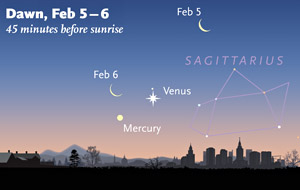S&T‘s Astronomy Podcast for February 2016
This month's audio sky tour starts before dawn, when you can spot all five bright planets by eye, and moves to the sparkling stars seen on winter evenings.
February is often the coldest month of the year for northerners, but the Sun is telling a different story. The December solstice came and went several weeks ago, and you can already notice that the days are getting longer, with earlier sunrises and later sunsets.

Mercury won't be well up in the morning sky for long, but on February 6th it creates a terrific triad with much brighter Venus and a very thin crescent Moon.
Sky & Telescope diagram
Sky & Telescope diagram
As February opens, be sure to head to head outside at least one day before sunrise. You’ll be rewarded with a showcase of bright stars and — get this — all five of the planets visible to the unaided eye.
In the evening sky, the stars of winter are in control of the nighttime firmament. You'll see the night sky’s most dazzling star is Sirius, down near the southeastern horizon even before twilight completely fades. Sirius serves as the lower anchor for the "Winter Hexagon," a big, wide pattern of bright stars with Orion's red-tinged superstar Betelgeuse at its center.
To get a personally guided tour of these night-sky sights and others overhead during February, download our 7-minute-long astronomy podcast below.
No comments:
Post a Comment